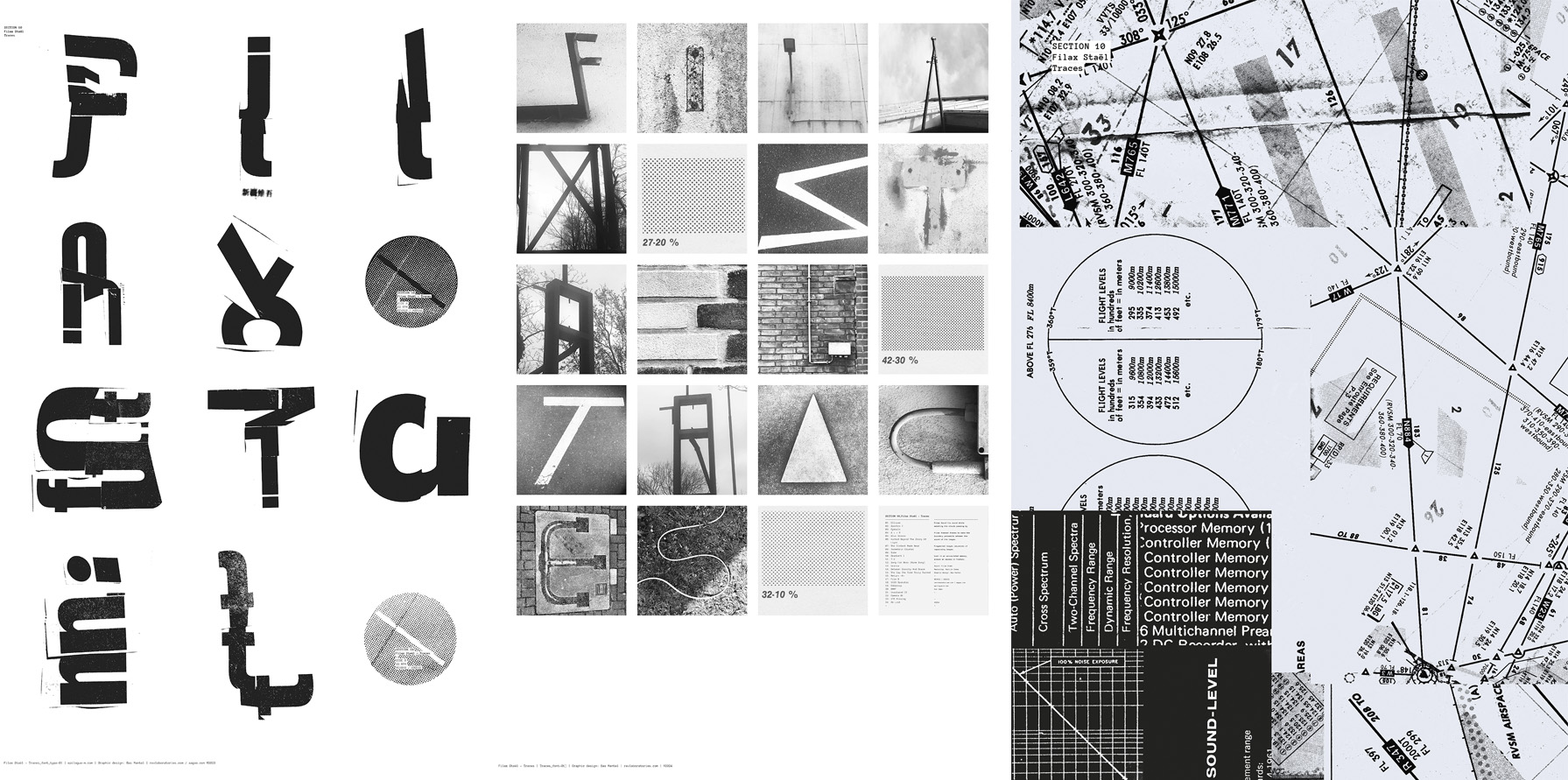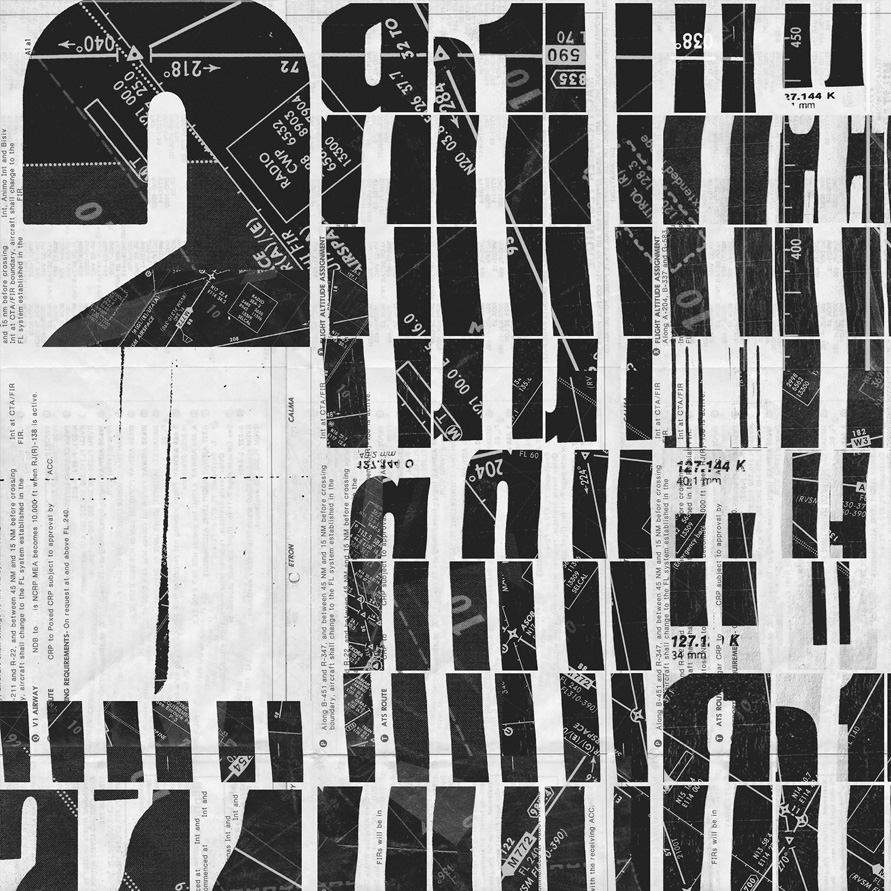Filax Staël
Traces
Design by Bas Mantel
Bas Mantel is an artist, musician, graphic designer and founder of Rev.Lab.Records, a print, sound and tone label based in Amsterdam. We spoke to Bas about the collaborative process that defines the Traces audio visual series and the complexities of creating cover artwork when you are the musician, composer, artist and graphic designer.
Released on Rev.Lab.Records (2024)
Hello. Please tell us about the brief and commission. Bas Mantel: I started Rev.Lab.Records in 2013, encouraged by my friend Alec Dartley, who runs Aagoo Records in New Jersey. The label was founded as a platform to release electronic, ambient, experimental, cinematic and abstract soundscapes. The Traces audio-visual release is a compilation of the Section 10_Traces by Filax Staël series that explores the relationship between the graphic interpretation of music and the possibilities of physical formats. It was ultimately compiled into the Traces vinyl album, Section_10 book (pictured below) and accompanying audio visual experiments.
I've been collecting sounds, sampling music, and recording environments using lo-fi equipment, such as tape cassette recorders, video and dictaphones, an 8 track cassette deck and telephones, since studying graphic design at art school in the late 1990's. But it wasn't until 2010 that I began collaborating with my friend Okko Perekki. We exchanged sampled materials and recorded sound collages as fragments cut out of our daily lives. They could be perceived as traces of ... Everything, somewhere, elsewhere, nowhere, anywhere.
A key principle of the Traces collaboration was to avoid any predetermined boundaries, allowing us the space to reinvent ourselves in complete freedom. In the first phase we shared individual ideas, sounds, concepts, recordings, and images. This evolved into creating compositions that were layered, but still retain the raw, spontaneous, experimental and non-conventional character of the original recordings.
My role as the musician, composer, artist and graphic designer are intertwined throughout the creative process. The concept for Traces through compiling, remixing, constructing and deconstructing elements in sound and image, opened the door to the world of Filax Staël, who is my pseudonym.
How did the music inspire the creative process?
Bas Mantel: The Traces release is characterised by a cut and paste approach that mixes rhythmic synth pulses, sound recordings from instructional films recorded in the 1950s, and orchestral symphonies from the silent film era. These elements are collaged with electronic noise, repetitive drum patterns, fragments of spoken words and twisted compositions from music boxes. The process is intuitive and raw.
The graphic design process is analogous to the way the sound collages were constructed. Graphic compositions were created using scissors, glue and traditional analogue printing techniques, such as xerox and fax machines, which were later edited in the computer, using Photoshop and Premiere, while retaining the raw atmosphere. I often look for imperfection in my graphic work and the Traces series is no exception, characterised by the use of monochrome colour, cut and paste imagery, typography and found footage, such as instruction manuals and flight maps, which are reinterpreted as new rhythmic and repetitive compositions.
The use of flight map artwork serves as a metaphor, inviting the listener into a space where they can explore the paths of a newly constructed (own) world of interconnected image and text fragments. How do we observe both the physical and invisible environment around us? How do we attempt to process them? There are no clear definitions or answers to be found during the reading or listening experience, but instead the reader is invited to immerse themselves in contemplation.




What did you research when developing ideas for artwork?Bas Mantel: The Traces project has been ongoing since 2013, and over time, multiple references and influences have touched the creative process. Visual inspiration came from Tomato, V23, Fluxus, Lettrism, Robert Rauschenberg, William Klein, Peter Tscherkassky and David Lynch. Music references include Seefeel, His Name Is Alive, Actress, Sonic Youth, and Godspeed You! Black Emperor.
Since art school, I've been working with Letraset (dry transfer lettering) or cutting letters from printed matter, such as newspapers and magazines, to create ‘visual typography’ collages. These imperfect ‘new’ letterforms are originally constructed outside the computer, by intuitively recomposing existing letters, shapes, textures and fragments, that are later adjusted in Photoshop to create a new print or edited in Premiere as a stop-motion film.
Please share an insight into the design development.
Bas Mantel: The Traces 10” vinyl is comprised of 24 tracks, each paired to a stop-motion film. These motion files were created through a process of mixing and remixing moving collages, either by cutting up previously made images and reassembling them, or dissecting them into still frames to create new compositions. This free form, experimental approach to design is parallel to the approach taken in creating the 24 audio compositions. Construct, deconstruct and then rebuild it as a new composition. Everything was possible.By 2022 we had composed music, more than 30 minutes of stop-motion film, and created posters, type experiments and graphic collages which could be compiled into a single release. The graphic collages Traces - Time Is The Longest Distance Between Two Places connected the graphic and musical compositions whereas the Traces music release was organised into themes like, memories, dream/reality, and time/space. The 24 stop-motion films were reworked in the ‘Section 10’ book, which serves as a visual manual containing film stills. Both the vinyl record and Section_10 book were distributed in a brown kraft envelope, with design elements from a cut and pasted flight map and rhythmically designed cut and pasted typography printed on the outside.
To conclude the project I asked Simon Taylor (Graphic designer and co-founder of Tomato, a London based design agency) to articulate his experience while navigating the Traces audio visual project. His ‘How do we read sound?' text contribution is a vital part of the overall experience.
The Traces project is ongoing and has no real end. It has already evolved into new image designs and is currently performed as audio visual live performances and graphic production processes.
Design by Bas Mantel
Special thanks: Alec Dartley and Simon Taylor
Buy the 'Traces' vinyl and 'Section 10' book here